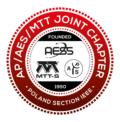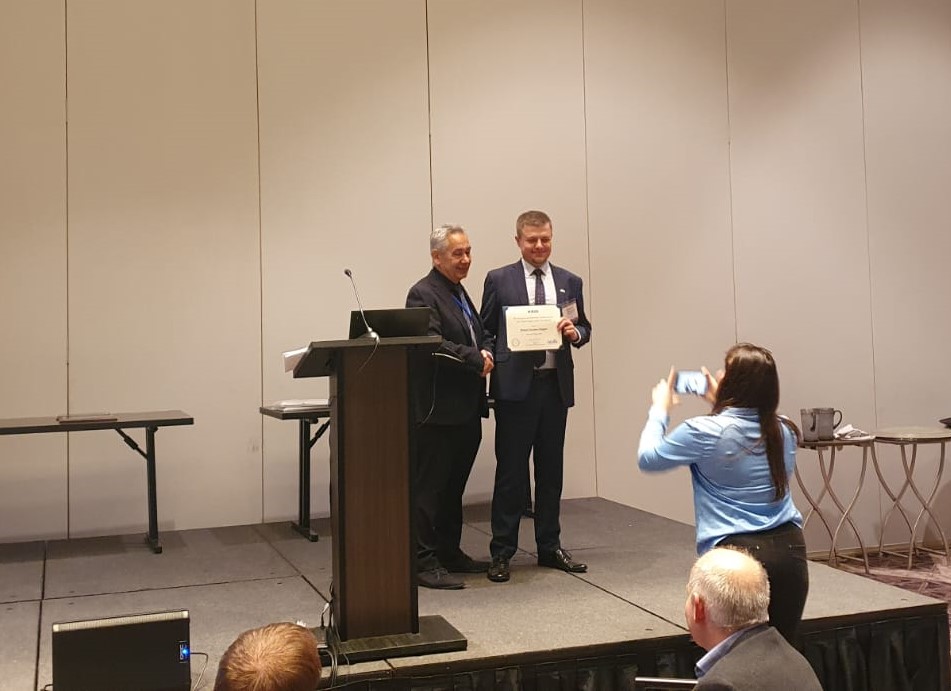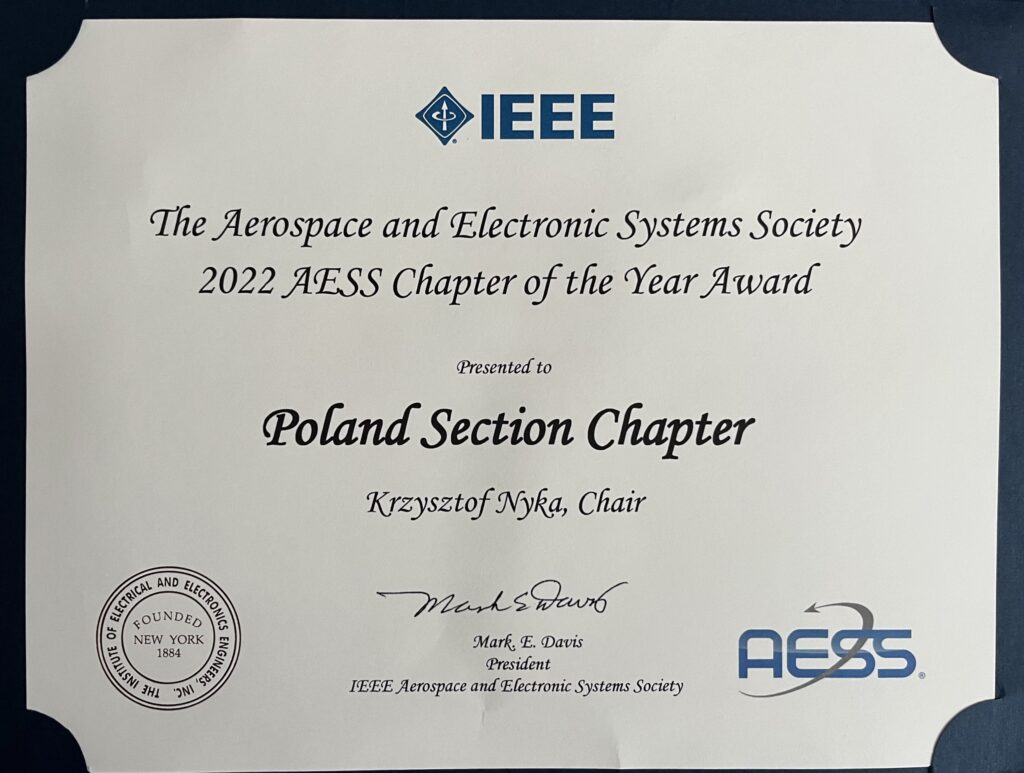Upcoming Lectures by DL Mark Davis
1) Ultra Wide Band Surveillance Radar
Date: 22.09.2023, 10:00-11:00 AM (UTC +1)
Location: Warsaw University of Technology, ul. Nowowiejska 15/19, Warsaw
Building: Faculty of Electronics and Information Technology
Room Number: 229
Ultra Wide Band Surveillance Radar is an emerging technology for detecting and characterizing targets and cultural features for military and geosciences applications. It is essential to have fine range and cross-range resolution to characterize objects near and under severe clutter. This Tutorial is divided into five parts.
• The Early History of Battlefield Surveillance Radar: Battlefield surveillance from manned and unmanned aircraft, along with early experiments in fixed and moving target detection and foliage penetration are covered. There were some very interesting developments in radar technology that enabled our ability to detect fixed and moving objects in dense clutter. Examples of airborne phased array antennas and UWB radars will be summarized.
• Surveillance Radar Modes: A summary of radar modes along with models of distributed clutter are shown. Analysis for Displaced Phase Center Array, Doppler Beam Sharpening, Ground Moving Rarget Indication are illustrated from early phased array antenna radars.
• UWB Phased Array Antenna: Electronically scanned antennas are widely used for surveillance of large areas. Wideband waveforms place a significant demand on the ESA design to maintain gain and sidelobe characteristics. Design of ESA systems with time delay steering and digital beamforming will be described.
• UWB Synthetic Aperture Radar (SAR): A brief description of several UWB surveillance SAR systems will be provided, along with illustrations of the SAR image and fixed object detection capability. Techniques developed for ultra-wideband and ultra-wide-angle image formation will be presented.
• Ultra Wideband Frequency Allocation Issues: A summary of world wide regulation on waveform designs is presented. The processes for obtaining frequency allocation are important in the new restrictions are summarized. A concept of cognitive radar that selects the waveform for a geographic region and adaptively cancels the radio frequency interference is presented.
• UWB Ground Moving Target Indication: Space time adaptive processing (STAP) has been used for over 20 years for detecting and tracking moving targets in clutter. As the resolution is improved for target characterization, the limits of STAP are tested. This section will discuss two approaches for increasing the bandwidth and maintaining geolocation accuracy: wideband STAP and Along Track Interferometry.
• New research in Multi-mode Ultra-Wideband Radar, with the design of both SAR and moving target indication (MTI) FOPEN systems. The last section of the tutorial will illustrate new technologies that have promise for future multimode operation: simultaneous SAR and GMTI in a multichannel radar.
2) Foliage Penetration Radar
Date: 29.09.2023, 10:00-11:00 AM (UTC +1)
Location: Wrocław University of Science and Technology, ul. Z. Janiszewskiego 8, Wrocław
Building: D-20
Room Number: 10
Foliage Penetration (FOPEN) Radar is a technical approach to find and characterize man-made objections under dense foliage, as well as characterizing the foliage itself. It has applications in both military surveillance and civilian geospatial imaging. This Tutorial is divided into three parts.
– The early history of FOPEN Radar: battlefield surveillance and the early experiments in foliage penetration radar are covered. There were some very interesting developments in radar technology that enabled our ability to detect fixed and moving objects under dense foliage. The most important part of that technology was the widespread awareness of the benefits of long dwell coherent radar and the advent of digital signal processing. Almost as important were the quantification of the radar propagation through foliage, and the impact of radio frequency interference on image quality.
– FOPEN synthetic aperture radar (SAR) with concentration on development results and technology from several FOPEN systems. These systems were developed for both military and commercial applications, and during a time of rapid awareness of the need and ability to operate in a dense signal environment. The techniques developed for ultra wideband and ultra wide-angle image formation will be presented. Finally there is a clear benefit for use of polarization in the target characterization and false alarm mitigation.
– New research in Multi-mode Ultra-Wideband Radar, with the design of both SAR and moving target indication (MTI) FOPEN systems. At common FOPEN frequencies, the systems have generally been either SAR or MTI due to the difficulties of obtaining either bandwidth or aperture characteristics for efficient operation. The last sections of the lecture will illustrate new technologies that are appearing in the literature with promise for future multimode operation.
Speaker:
Mark Davis
Mark Davis has over 45 years experience in Government and Industry in developing technology and systems for Radar and Electronic Systems. In 2008 he established medavis consulting as a Sole Proprietorship, to assist in review and development of advanced sensor systems, with customers in Government, Industry and Small Businesses. He held senior management positions at DARPA as Deputy Director Information Exploitation Office (2006-08), Technical Director for Air Force Research Laboratory Space Based Radar Technology (1998-2006) and Program Manager in DARPA Information Systems Office for Counter CC&D technologies (1995-1998). Dr Davis also had senior Engineering and Program Management positions with General Electric Aerospace, and General Dynamics Missile Systems. His interests are in Radar and microwave system design, phased array antennas and adaptive signal processing. Dr Davis is a Life Fellow of the IEEE, a Fellow of the Military Sensing Symposia, and Chair of the IEEE Radar Systems Panel. Within the IEEE Aerospace and Electronics Systems Society, he has been a member of the Board of Governors (2008-2013) holding positions of VP of Conferences (2010-2012) and VP of Finance (2013). Dr Davis is currently serving on the US Air Force Scientific Advisory Board, and is a member of the NASA review board on earth resource monitoring. He has received a PhD in Physics from The Ohio State University, and Bachelor and Masters Degrees in Electrical Engineering from Syracuse University. In addition to these technical duties, he has published over 75 journal and conference papers on Radar and Microwave Systems. More recently, he has authored a book Foliage Penetration Radar – Detection and Characterization of Objects under Trees published by Scitech Publishing in March 2011, and a Chapter on Principals of Modern Radar on FOPEN.
AESS Position(s):
President (2022-2023); BoG (2018-2020) (2015-2017); President-Elect (2020-2021); VP Conferences (2016-2018); AESS Distinguished Lecturer (2020-2022); IEEE Fellow
IEEE AESS Position History:
2022-Present President (Officers)
2021-2022 Conferences Committee Member (Conferences Committee)
2021-2021 Finance Committee Member (Finance Committee)
2020-2021 President-Elect (Officers)
2018-2020 Members-at-Large (BoG)
2015-2018 Vice President Conferences (Officers)
2015-2018 Vice President Conferences (Conferences Committee)
2013-2013 Vice President Finance (Officers)
2013-2013 Vice President Finance (Finance Committee)
Recognitions:
2020-2024 Distinguished Lecturer
2018 IEEE Dennis J. Picard Medal
2011 Warren D. White Award





